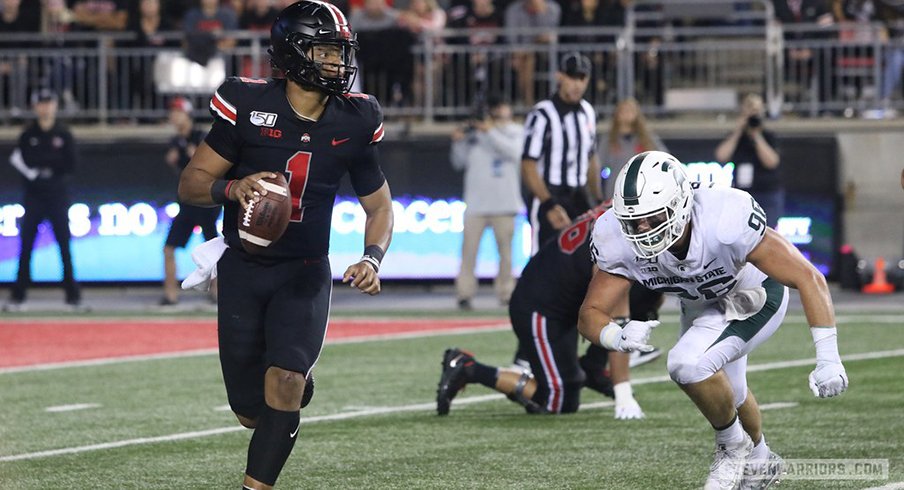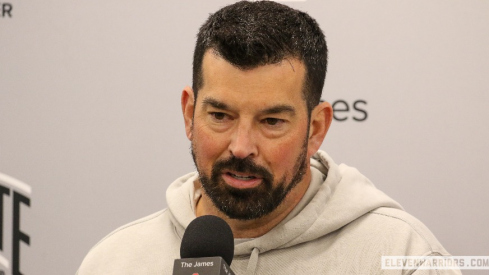There was just under six minutes left in the fourth quarter of the 2013 Big Ten Championship Game when Mark Dantonio's Michigan State team stood up to Ohio State.
It was 4th-and-1 on the Spartans' 39-yard line as the Buckeyes trailed 27-24. The ball was snapped and the call was a quarterback sweep for Braxton Miller to the short side of the field. Tight end Jeff Heuerman missed his block, allowing Denicos Allen to break into the backfield and wrangle Miller down for no gain.
On the ensuing drive, Michigan State running back Jeremy Langford broke through the Ohio State defense and scored on a 26-yard touchdown run.
Michigan State's 34-24 victory over Ohio State in the 2013 Big Ten Championship Game was its arrival moment. It had spent the years leading up to that season fighting for relevancy in the Big Ten. It started with standing up to its chief rival in Michigan, then continued as it Dantonio's strong defense stiffened to elite status.The Spartans certainly had good seasons leading up to the '13 campaign, but never a great one.
That changed specifically on this night, and not just because Michigan State won its first non-shared Big Ten title since 1987. It changed because Dantonio and the Spartans stood up to Urban Meyer and Ohio State, which had won 24 consecutive games coming into the night and needing just one more to play in the BCS National Championship Game.
Between 2012-16, Ohio State and Michigan State traded blows. The Buckeyes won that first matchup 17-16 in East Lansing. The Spartans retaliated with that Big Ten title win the following year. In '14, J.T. Barrett had one of the best performances of his collegiate career in leading Ohio State to a 49-37 win. Michigan State responded with a stunning 17-14 upset over the Buckeyes in Ohio Stadium 12 months later. And then finally, in 2016, Ohio State avoided another upset with a 17-16 win that mirrored the score of Meyer's battle against Michigan State.
No team challenged Meyer's Buckeyes in his first five seasons more than Dantonio's Spartans. Michigan State won two Big Ten titles during the span and made one playoff appearance, while Ohio State won a conference title and made the playoffs twice.
But the Michigan State program was never really the same after suffering a 38-0 blowout loss to Alabama in the 2015 playoff. The following year they went a dismal 3-9. 2017 looked like a bounce-back year with a 10-3 campaign, but back-to-back seven win seasons in 2018-19 had the Spartans back as a middle-of-the-road Big Ten team.
Dantonio's sudden resignation in the face of NCAA violation allegations put Michigan State in a coaching search for the first time in 14 years. They made a run at former Ohio State defensive coordinator Luke Fickell hoping he could repeat Dantonio's success. Fickell turned the opportunity down and opted to stay at Cincinnati, which turned the program's attention to another former Ohio State defensive coach in Mel Tucker.
Tucker coached the Buckeyes' defensive backs during Ohio State's title run in 2002 and was promoted to co-defensive coordinator in 2004. He then made the jump to the NFL and spent a decade at Cleveland, Jacksonville and Chicago before re-entering the college ranks at Alabama (2015) and Georgia (2016-18).
Tucker accepted his first head coaching job at Colorado in 2019 and led the Buffaloes to a 5-7 campaign, equalling the win total in each of the program's previous two seasons.
Michigan State paid big to lure Tucker away from Colorado, giving him a salary worth more than 5.5 million annually over six years, which is more than Ohio State is currently paying Ryan Day to lead the football program. In fact, the contract made Tucker the 12th highest paid coach in all of college football.
The Spartans did so because they believe Tucker can build the Michigan State program back up to elite status. But to do so, a lot has to change.
Recruiting in the Big Ten, specifically in the East Division, has drastically changed since Meyer took over Ohio State in 2012 and Jim Harbaugh and James Franklin joined the league in 2015. With Day now at the helm of the Buckeyes, the division has a trio of coaches that will routinely assemble classes that rank inside the top 10 nationally.
The Spartans' last four recruiting classes ranked No. 43, No. 33, No. 31 and No. 36, respectively. There's plenty of talent on the roster Tucker inherited, but when you consider Ohio State's classes ranked No. 2, No. 2, No. 14 and No. 5 during that span, there's a legitimate talent gap that exists between the two programs.
During that first stretch of Meyer's tenure, Dantonio found a way to bridge Michigan State's talent gap and contend with Ohio State. That's the biggest challenge Tucker faces as he enters one of the toughest divisions in all of college football.


